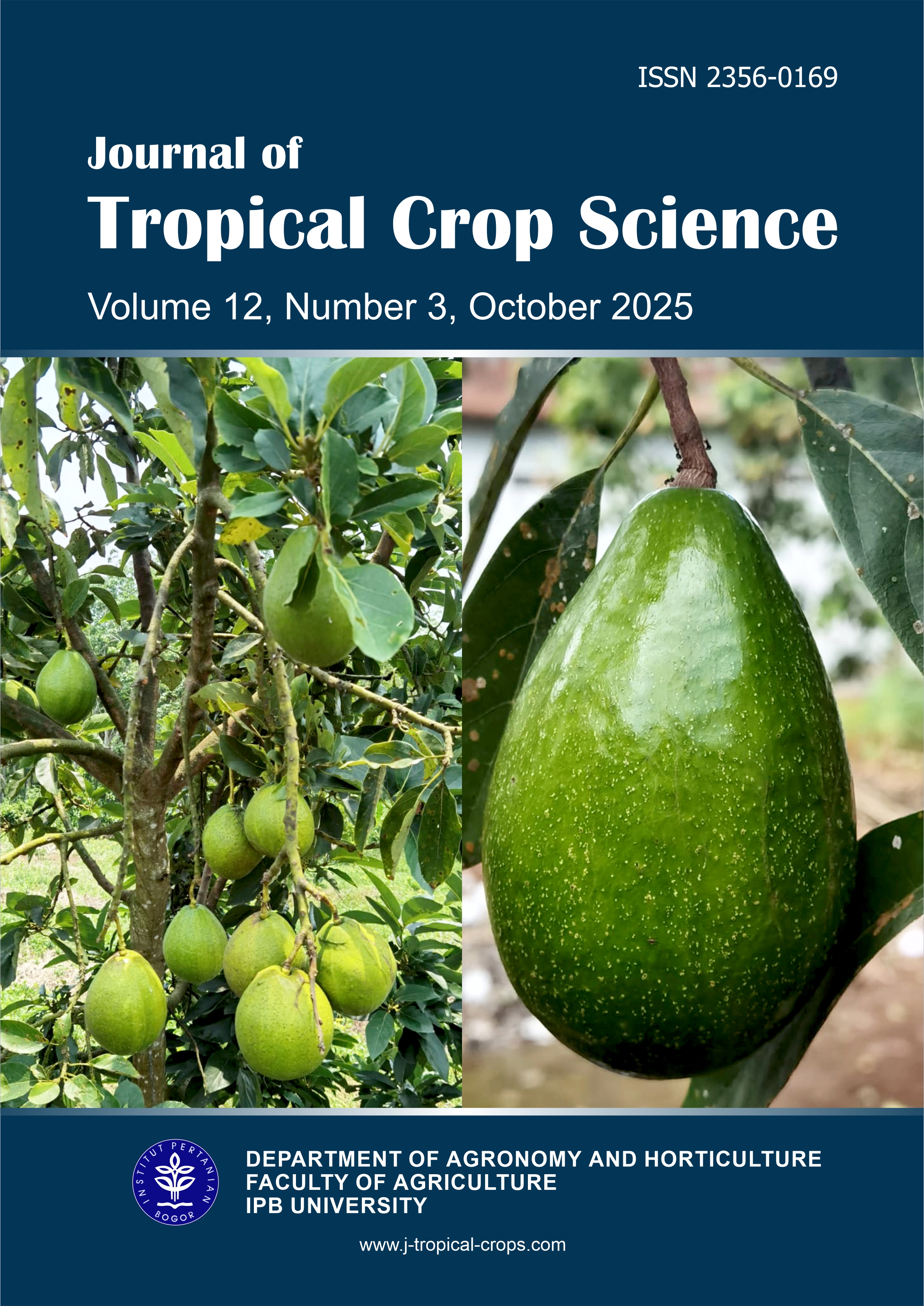Seasonal Activity of the Pomegranate Fruit Moth Ectomyelois ceratoniae Zeller and its Possible Integrated Control in Ain al-Tamr, Karbala Governorate, Iraq
DOI:
https://doi.org/10.29244/jtcs.12.03.695-701Keywords:
Ain al-Tamr, Beauveria bassiana, botanical oils, Ectomyelois ceratoniae, integrated pest management, pomegranateAbstract
The pomegranate fruit moth, E. ceratoniae Zeller, is a significant pest of pomegranate worldwide. Seasonal monitoring and integrated control trials were carried out in pomegranate orchards of Ain al-Tamr, Karbala Governorate (Iraq) during the 2024 growing season (15 May–15 September 2024). Regular adult male f light began in early May and continued until mid September, peaking in mid-August (35.15 male moth per trap) at a mean ambient temperature of 35.85°C and a relative humidity of 20.47%. Field trials evaluated botanical oils (thyme and juniper, 7% v/v), the entomopathogenic fungus Beauveria bassiana (commercial formulation), their combinations, and the insecticide imidacloprid (Imidor 200 SL) under a randomized complete block design. Treatments and monitoring (pheromone traps) were repeated following two sprays (7 June and 7 July 2025). Combined B. bassiana + 7% thyme oil provided control comparable to Imidor, reducing fruit infection to 3.3% and trap captures to 1 male per trap, whereas B. bassiana alone reduced infection to ~10% and trap captures to five males per trap. Overall, treated plots averaged 13.31% infection, compared to 55% in controls, after the second spray. Statistical analyses (ANOVA, post hoc tests) confirmed significant treatment effects. These findings indicate that integrating B. bassiana with botanical oils can effectively reduce E. ceratoniae infestation and may serve as a sustainable alternative to routine chemical control in Ain al-Tamr pomegranate orchards.
References
Abada, A., Ksentini, I., and Laarif, A. (2019). Encapsulation technologies for enhancing the stability of botanical insecticides. Journal of Pest Science 92, 1309–1324.
Abbas, H.I., and Al-Khazraji, H.I. (2025). Evaluation of the relative efficiency of some insecticides in controlling pomegranate fruit moth, Ectomyelois ceratoniae (Zeller) (Lepidoptera: Pyralidae). IOP Conference Series: Earth and Environmental Science 1487, 012021. DOI: https://doi.org/10.1088/1755-1315/1487/1/012021.
Abedi, Z., Golizadeh, A., Soufbaf, M., Hassanpour, M., Jafari-Nodoushan, A., and Akhavan, H.R. (2019). Relationship between performance of carob moth, Ectomyelois ceratoniae Zeller (Lepidoptera: Pyralidae) and phytochemical metabolites in various pomegranate cultivars. Frontiers in Physiology 10, 1425. DOI: https://doi.org/10.3389/fphys.2019.01425.
Al-Ghafar, M., et al. (2024). Biochemical and toxicological effects of Beauveria bassiana extracts against Tuta absoluta larvae. Frontiers in Microbiology 15, 1336334.
Amri, I., et al. (2014). Insecticidal activity of Thymus capitatus essential oil against stored-product pests. Chilean Journal of Agricultural Research 74, 247–254. DOI: https://doi.org/10.4067/S0718-58392014000300004.
Aziz, F.M., Al-Janabi, D.S., and Nimah, R.A. (2014). Laboratory studies on the effect of the fungus Beauveria bassiana on the red leafhopper Batrachedra amydraula (Lepidoptera: Cosmopterygidae). Iraqi Journal of Science 55, 643–648.
Demirel, N. (2025). A study on the occurrence and population trends of the carob moth Ectomyelois ceratoniae (Zeller), in pomegranate orchards by using pheromone traps. Environmental Entomology 54, 123–130. DOI: https://doi.org/10.1093/ee/nvz123.
Farahani, N., and Bandani, A.R. (2023). Effects of plant essential oils on oxidative stress and heat shock protein expression in Ectomyelois ceratoniae. Environmental Entomology 52, 567–578. DOI: https://doi.org/10.1093/ee/nvad034.
Hamad, S., Ben Chaaban, S., and Jemni, M., et al. (2024). Effect of physico-chemical properties of some pomegranate varieties from Tunisia on the infestation of fruits by Ectomyelois ceratoniae Zeller (Pyralidae) and Deudorix (Virachola) livia Klug (Lycaenidae). Arthropod Plant Interactions 18, 927–942. DOI: https://doi.org/10.1007/s11829-024-10057-6.
Karami, E., Dastjerdi, H.R., and Ghasemi, V. (2022). Effect of thyme essential oil and its main components on toxicity and physiological parameters in Glyphodes pyloalis. Environmental Science and Pollution Research 29, 5638–5648.
Kowalska, A., Bąk, B., and Nowak, R. (2023). Larvicidal and antifeedant activities of Juniperus horizontalis essential oil and sabinene against Tenebrio molitor. Molecules 28, 8408.
Liu, C., and Zhang, Y. (2025). Climate change facilitates the establishment of potentially suitable habitats for Ectomyelois ceratoniae (Zeller) in pomegranate-growing regions. Atmosphere 15, 119. DOI: https://doi.org/10.3390/atmos15010119.
Mahot, H.N. et al. (2025). Compatibility of entomopathogenic fungi with different vegetable oils for improved conidial viability and efficacy. Cameroon Journal of Biological Sciences 18, 45–56.
Mousavi, M., Rezaei, M., and Habibi, H. (2024). Insecticidal effects of extracts and wettable powder formulations of Thymus spp. against Helicoverpa armigera. Entomological News 131, 401–410.
Nay, J.E., and Perring, T.M. (2005). Impact of ant predation and heat on carob moth (Lepidoptera: Pyralidae) mortality in California date gardens. Journal of Economic Entomology 98, 725–731. DOI: https://doi.org/10.1603/0022-0493-98.3.725.
Noreen, S., Ahmad, M., Tariq, A., and Khan, H. (2025). Phytochemicals and pharmacology of pomegranate (Punica granatum): A 2025 review. Frontiers in Nutrition 12, 1587345. DOI: https://doi.org/10.3389/fnut.2025.1587345.
Proietti, S., et al. (2023). Molecular interactions of Beauveria bassiana with insect hosts: Insights from transcriptomic analyses. Frontiers in Microbiology 14, 1156321. DOI: https://doi.org/10.3389/fmicb.2023.1156321.
Rat, I., and Mamay, M. (2024). Alternative management strategies for carob moth Ectomyelois ceratoniae Zeller (Lepidoptera: Pyralidae) in pomegranate orchards. Journal of Plant Diseases and Protection 131, 167–176. DOI: https://doi.org/10.1007/s41348-023-00820-x.
Semerdjieva, I., Zheljazkov, V.D., Radoukova, T., Dincheva, I., Piperkova, N., Maneva, V., and Kačániová, M. (2021). Biological activity of essential oils of four juniper species and their potential as biopesticides. Molecules 26, 6358. DOI: https://doi.org/10.3390/molecules26216358.
Teimouri, N., and Jafari Nadooshan, A. (2014). Biological characteristics of carob moth Ectomyelois ceratoniae (Zeller) (Lepidoptera: Pyralidae) on two commercial pistachio cultivars and artificial diet. Iranian Journal of Biology 27, 207–218.
Trandafir, I., Stoica, R., and Dobre, A. (2022). Chemical composition and insecticidal potential of Juniperus essential oils. Molecules 27, 6358.
Verdi, M.Z., Abbasipour, H., and Chegini, S.G. (2019). Phytochemical and insecticidal study of the Avishan-e-denaii (Thymus daenensis Celak.) essential oil against the melon aphid (Aphis gossypii Glover). Journal of Essential Oil Bearing Plants 22, 545–553. DOI: https://doi.org/10.1080/0972060X.2019.1618739.
Wu, J., et al. (2022). Chemical composition and insecticidal activity of Juniperus essential oils. Journal of Pest Science 95(2), 521–534. DOI: https://doi.org/10.1007/s10340-021-01421-9.
Yaghobi, S., Rajabpour, A., and Zandi-Sohani, N. (2020). Seasonal population dynamics, sampling distribution, and fixed-precision sequential sampling of Spectrobates ceratoniae (Lepidoptera: Pyralidae) in pomegranate orchards. Journal of Economic Entomology 113, 1513–1518. DOI: https://doi.org/10.1093/jee/toaa004.
Downloads
Published
How to Cite
Issue
Section
License
All publications by Journal of Tropical Crop Science is licensed under a Creative Commons Attribution-ShareAlike 4.0 International License.






